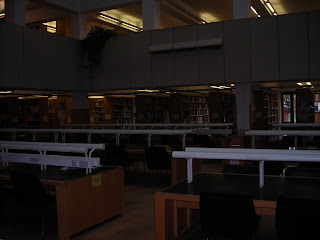
August 1, 2008 (Site Visit)
http://www.westminster.gov.uk/libraries/findalibrary/marylebone.cfm
For my third independent site visit I decided to visit a public library, as the only other public library we saw as a class was the Barbican. Marylebone is a branch of the Westminster Library system. I was interested to learn that they don't have a 'main' branch. Their library is currently in a temporary location, so they are somewhat limited on space. For example, although they had a separate children's floor in their previous space, the children and adult collections are currently in the same room (although they did a lovely job of giving children their own corner within the adult library).
The room that houses the children and adult collections has a selection of 'Quick Choices' for adults right by the entrance. There are also rather fancy ATM-esque machines for borrowing books, renewing books, returning books, and paying fees. They even have a shorter one that is for children and handicapped individuals. They also have displays in the center of the room for graphic novels and manga and for audio books (both cassette and CD). A corner in the front housed the DVD section.
The children's corner is in the back of the room. They have two computers set aside for children and one for teenagers. All of their teenage collection seemed to be on a couple of shelving units marked 'Zone Fiction' and 'Zone Non-Fiction', and all of the books on those shelves were marked on the spine with an orange sticker printed with a 'Z'. I thought that was an interesting way to designate teen books. Children's information books were also marked on the spine with different picture symbols printed on yellow stickers to denote animals, body, countries, crafts, entertainment, food, history, knowledge, languages, living, nature, people, religion, science, space, sports, and transport. The children's section itself had a rug next to low boxes filled with picture books. I was told they receive about 500 users a day Monday through Friday and around 300 on Saturdays and Sundays. In their downstairs area, they have about 10 full time staff.
The information and computers section was upstairs. Interspersed amongst the shelves of reference books were sections of computer terminals. They had about fourteen in one section and ten in another. The computers required the input of a card number and a pin code to log in. They also had 15 computers in the back set aside as training centers. The woman at the help desk near those computers said that they were part of a 'learn to read' center. They get approximately twenty new learners each month. There is also a reference desk for the main part of the library. They also have a section of books for sale as well as a reading area stocked with magazines and newspapers.
Despite their temporary location, I thought that it was a very nice branch library with a very pleasant and welcoming atmosphere.
http://www.westminster.gov.uk/libraries/findalibrary/marylebone.cfm
For my third independent site visit I decided to visit a public library, as the only other public library we saw as a class was the Barbican. Marylebone is a branch of the Westminster Library system. I was interested to learn that they don't have a 'main' branch. Their library is currently in a temporary location, so they are somewhat limited on space. For example, although they had a separate children's floor in their previous space, the children and adult collections are currently in the same room (although they did a lovely job of giving children their own corner within the adult library).
The room that houses the children and adult collections has a selection of 'Quick Choices' for adults right by the entrance. There are also rather fancy ATM-esque machines for borrowing books, renewing books, returning books, and paying fees. They even have a shorter one that is for children and handicapped individuals. They also have displays in the center of the room for graphic novels and manga and for audio books (both cassette and CD). A corner in the front housed the DVD section.
The children's corner is in the back of the room. They have two computers set aside for children and one for teenagers. All of their teenage collection seemed to be on a couple of shelving units marked 'Zone Fiction' and 'Zone Non-Fiction', and all of the books on those shelves were marked on the spine with an orange sticker printed with a 'Z'. I thought that was an interesting way to designate teen books. Children's information books were also marked on the spine with different picture symbols printed on yellow stickers to denote animals, body, countries, crafts, entertainment, food, history, knowledge, languages, living, nature, people, religion, science, space, sports, and transport. The children's section itself had a rug next to low boxes filled with picture books. I was told they receive about 500 users a day Monday through Friday and around 300 on Saturdays and Sundays. In their downstairs area, they have about 10 full time staff.
The information and computers section was upstairs. Interspersed amongst the shelves of reference books were sections of computer terminals. They had about fourteen in one section and ten in another. The computers required the input of a card number and a pin code to log in. They also had 15 computers in the back set aside as training centers. The woman at the help desk near those computers said that they were part of a 'learn to read' center. They get approximately twenty new learners each month. There is also a reference desk for the main part of the library. They also have a section of books for sale as well as a reading area stocked with magazines and newspapers.
Despite their temporary location, I thought that it was a very nice branch library with a very pleasant and welcoming atmosphere.















